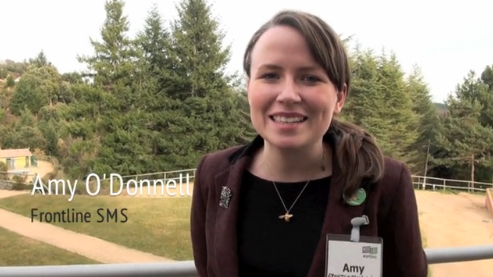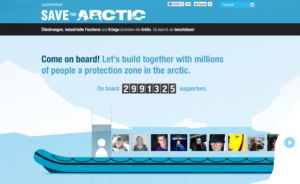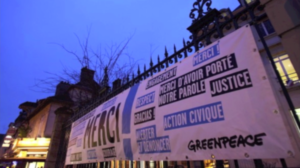SANT HILARI SACALM, Spain – When organizers first started using the Internet for organizing there was a clear line between online and offline actions. We’ve come a long way since then, understanding the need to fuse online and offline interaction into a seamless web of engagement and change.
On the second day of Greenpeace’s Digital Mobilisation Skillshare (GPDMS), Greenpeace USA national activist network director Mary Nicol convened a group to talk about some of the best integrated online-offline mobilisation they’ve since in the past year.
A later session explored what it will take to pull off Greenpeace’s biggest global online/offline mobilisation yet!
Check out our brief rundown of some of these creative campaigns integrating online and offline. And don’t forget to view our short video featuring two field leaders: Mary, as she speaks to this convergence, and Amy O’Donnell from FrontlineSMS, who makes the case for mobile first. Here we go:
4 Creative campaigns integrating online-offline
Colossal human chain to stop nuclear
The Fukushima disaster re-ignited Germany’s anti-nuclear movement with at least 50,000 people gathering on March 12, 2011 to form a human chain spreading from a nuclear power plant in Neckarwestheim to the city of Stuttgart.
The campaign started as a Facebook page, with a number of organizations including Greenpeace co-ordinating the outreach through social media. The team used SMS to text reminders to people who signed up, and organized buses to courier people to the location. Tweets from people at the event made the issue go global.
What made it work: It was the right political moment, a compelling simple ask, strong Facebook engagement and awareness building, as well as good on-the-ground logistics to turn people out.
Food bank fundraiser:
When the Belgium National Lottery association wanted to host a fundraiser for Belgium Food Banks, it took an unconventional approach and built an interactive online/offline campaign.
For each Facebook like, the National Lottery would donate $1 to Belgium Food Banks. Nothing new there, but the National Lottery took it one step further and live streamed volunteers printing supporter’s Facebook images directly after they liked the campaign and pinning the pictures onto a massive wall.
The supporters who donated their Facebook image could watch their picture being posted in real time, joining what would become 15,000 donors.
The campaign also followed-up with supporters, asking them to volunteer for a couple of hours as part of the 24-hour volunteer image collecting and posting campaign. They were able to recruit 100 volunteers for the five-day event. When the campaign finished, the National Lottery sent out a time-lapsed video capturing the creation of the Facebook profile wall thanking supporters.
What made it work: An easy entry point – like us on Facebook, live creation of picture wall a novel approach, small volunteering ask, follow-up thank-you video builds ownership over successful community fundraiser.
H&M commits to detox:
As part of Greenpeace’s Detox campaign, the online offline strategy asked supporters to do a week of “sticker actions,” sticking huge “Detox our future!” and “Detox our water!” stickers on the shop windows of H&M stores, some supporters even tagged clothing, in 12 countries. The stickers resulted in store managers calling the clothing headquarters, which helped raise alarm bells at the Swedish fashion giant’s head office.
Online activists and H&M fans from around the world also called on the Swedish retailer to detox on Twitter and Facebook.
What made it work: The detox stickers were a highly visible tactic to raise awareness. The stickers in conjunction with massive social media calls for change created bad branding for the clothing retailer, pressuring them to agree to detox.
Show your love for the Arctic (Upcoming)
If everything goes as planned, when the governing body for the Arctic, the Arctic Council, meets for its biannual meeting in April they will hear a global message: we love the Arctic and we want you to protect it.
Greenpeace is planning its biggest global mobilisation, with 20 offices representing 30 countries co-creating events with their volunteer networks to host massive on-the-ground protests April 20.
Greenpeace volunteer teams will also serve as mobilisation hubs in areas where there are no Greenpeace offices, encouraging more people to come up with creative displays demonstrating their love for the Arctic.
During the event, Greenpeace will be encouraging supporters to upload photos live to Twitter and Instagram using the hashtag #Ilovethearctic. The pictures and messages will be aggregated and viewable on the Save the Arctic website, as well as sent to the Arctic Council.
Why they think it will work: The event is modelled after 350’s overwhelmingly successful day of action, which in 2009 mobilised people in 181 countries to come together at more than 5,000 events. The approach allows people to join an event, not an organization, and co-ordinate their own activities while being part of a global movement. 350.org acted as a convener and created the tools to make the world’s voices a powerful ‘one.’
GPDMS runs until Feb.7. Follow live tweets and news on our event page.
More GPDMS coverage:
Upwell’s social media monitoring secrets and superpowers
Categories:
tech, tools and tactics



